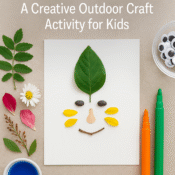
DIY Puppet Theater Kits: Creative Storytelling at Home
Why Kids Struggle to Tell Stories in a Screen-Filled World
Children love stories, but when passive screen time replaces active storytelling, creativity and communication often suffer. Many parents wish their kids had more opportunities to act out ideas, practice public speaking, and build confidence through role-play. Enter the DIY puppet theater kit.
This hands-on activity revives traditional storytelling with a modern twist—imagination meets creation.
How Puppet Theater Supports Child Development
Puppet storytelling gives children:
- A chance to rehearse language and dialogue
- Tools to manage emotions and practice empathy
- Practice with sequencing and dramatic structure
- A way to collaborate and solve creative problems
It aligns perfectly with our Story Cards for Character Building and Backyard Theater activities—encouraging imagination through structured play.
Step-by-Step Puppet Theater Setup
(Time: 45–60 min | Difficulty: ★★☆)
Materials You’ll Need:
- Cardboard box, scissors, tape
- Markers, scrap paper, old fabric for curtains
- Popsicle sticks or straws
- Printable puppet templates from our PDF kit
Instructions:
- Build Your Stage
- Cut out a window from the cardboard box front.
- Decorate the outside with signs, stars, or curtains.
- Create Your Characters
- Use our templates or draw your own.
- Colour, cut, and tape each puppet to a stick.
- Write Your Mini Script
- Use story prompts or invent your own!
- Keep it short and fun (2–4 minutes).
- Rehearse and Perform
- Practice voice changes and actions.
- Perform for siblings, pets, or stuffed animals.
- Reflect and Replay
- Talk about what each character felt or learned.
- Encourage sequels or new cast members.
reative Expansion Ideas
Voice and Performance Tips
- Practice speaking in different pitches, tones, or accents.
- Match your voice with emotions: make it shaky when scared, loud when surprised, or soft when shy.
- Encourage kids to act out feelings with puppet movement.

Themed Puppet Shows to Try
- Seasonal Shows: Halloween Haunt, Summer Splash, Winter Quest
- Classic Twist: Three Little Pigs in Space, Goldilre special types of bridges where the road is held up by strong cables. These cables are stretched between tall towers, and more cables hang down to support the road. In 1826, Thomas Telford completed the Menai Suspension Bridge in Britain, using wrought-iron chains toocks at the Zoo
- STEM Storylines: A robot discovers music, a scientist talks to frogs
Group Variants for Multiple Kids
- Assign roles: director, puppeteer, voice actor, stage crew
- Do a show in 2 acts: team A for act 1, team B for act 2
- Record the show and add background music later
Creative Replay Prompts
- “What if the hero turns into the villain halfway through?”
- “Add a magic item halfway into the story. What changes?”
- “Let another player change the ending—how does it go now?”
Family Theater Plan: Turn a Weekend into a Mini Show Festival
Want to go beyond one-off shows? Here’s a 3-day family challenge that turns your living room into a storytelling stage:
- Day 1: Brainstorm & Design
- Everyone draws one character and one setting. Combine ideas into one big story.
- Start designing puppets and background props.
- Day 2: Rehearse & Create Music
- Pick background music (even pots and pans work!)
- Practice lines, add props, and rehearse at least twice.
- Day 3: Showtime!
- Print mini tickets and invite family members.
- Record the show to rewatch and reflect.
- End with awards like “Best Voice Acting” or “Funniest Moment.”
This format builds anticipation, teamwork, and celebration into one magical weekend.
Sample Puppet Script: “The Lost Button”
Characters: Button Bunny, Old Owl, and a Storm Cloud
Setting: Inside a messy sewing basket
Conflict: Bunny’s magic button is missing, and the basket is about to be cleaned!
Resolution: Owl helps Bunny remember where it rolled—and they find it under a thimble just in time.
Let kids illustrate, perform, or even rewrite endings. Use this starter or create a new one based on your own puppet personalities.
What Families Are Saying
“My daughter made her own puppet about a lost bear. She performed the show three times for her grandparents!” — Tamika, NSW
“This was perfect for rainy day play. It kept my two boys engaged for over an hour without screens.” — Rohan, SA
Download the DIY Puppet Theater Kit (PDF)
Includes:
- Puppet character templates (human, animal, and blank)
- Script starter cards
- Puppet stage design guide
- Award Certificate: “Junior Puppet Performer”
FAQ: Common Questions About Puppet Theater Kits
Q: What age is best for this?
A: Ideal for kids aged 5–9. Younger kids may need help cutting or taping puppets.
Q: What if we don’t have a box?
A: Hang a towel over a table edge, or use a large cereal box.
Q: Can this be done with a group?
A: Absolutely! Try it as a party activity or co-op group project.
Alt Text Suggestions for Blog Images
- DIY cardboard puppet theater with curtains and puppet hands showing
- Tabletop spread of puppet templates, markers, and sticks
- Child performing a story with handmade puppets
Let Kids Be the Storytellers
The magic of puppet play lies in how it transforms shy storytellers into confident performers. Kids not only speak their thoughts aloud—they invent, adapt, and respond. And best of all, they laugh, learn, and create together.
Whether at home, in the classroom, or as part of a rainy day kit, a simple puppet box can open a world of imagination.




